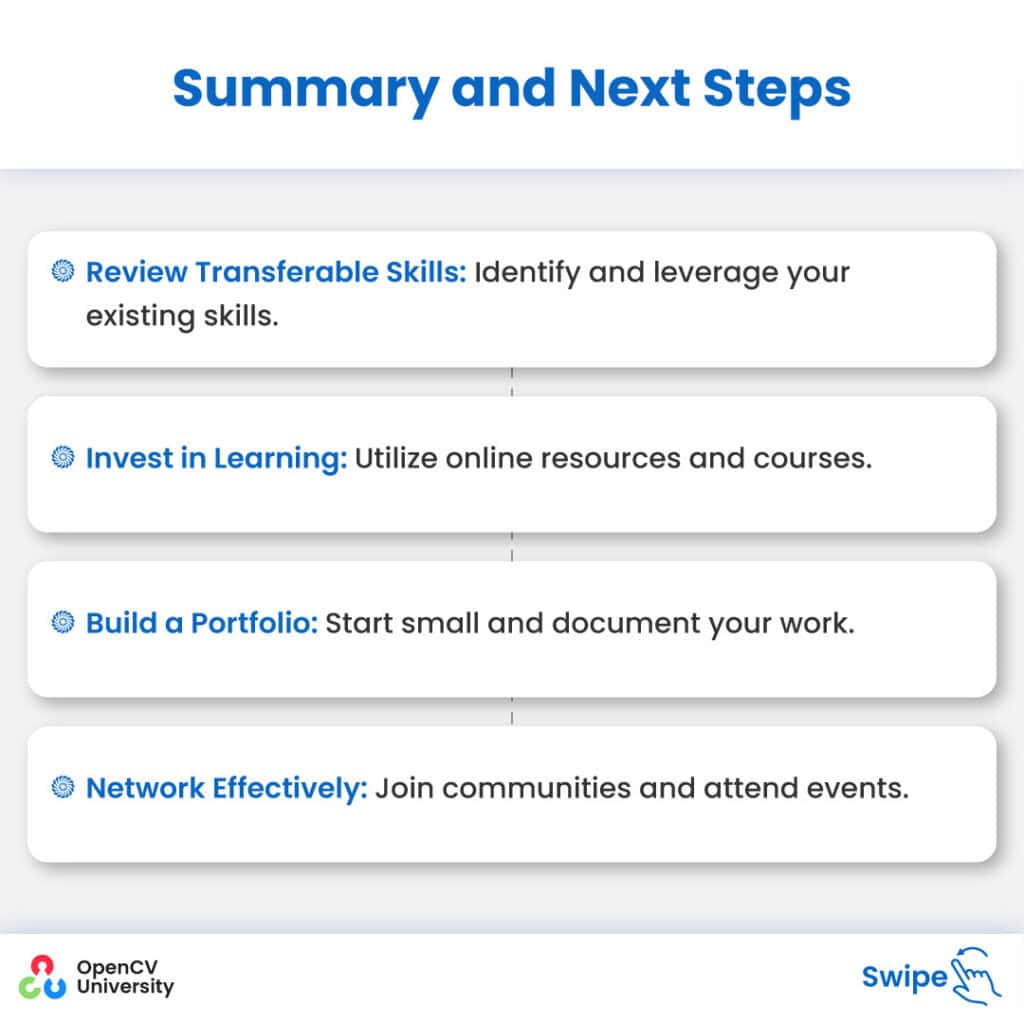10 Interview Questions for Senior Computer Vision Engineers: Practical Insights and Strategies
Preparing for an interview as a senior computer vision engineer means diving into topics beyond entry-level machine learning. Interviewers aim to assess both your technical expertise and your problem-solving approach.
Here’s a guide to some of the most common interview questions, along with why they’re important, what employers are looking for, and practical hints for answering them effectively.
1. Advanced Neural Network Design

Why the Question is Important:
Creating custom architectures is crucial in computer vision since generic models often don’t meet the specific needs of complex tasks. This question assesses if you can design networks with the flexibility and creativity to solve unique problems.
What Employers Are Looking For:
Employers want to see if you understand the core principles of network design and can adapt architectures to meet performance goals. They are interested in your ability to balance accuracy and efficiency.
Hint:
Think of a project where you added or adjusted layers (e.g., residual connections) or changed the network depth to achieve a specific outcome. Explain your thought process and how these modifications impacted results.
Example Scenario:
Imagine a project requiring high-resolution image segmentation for medical imaging. You might describe how you modified a U-Net architecture to improve boundary detection or added a specific loss function for accuracy in detecting small features.
2. In-Depth Transfer Learning

Why the Question is Important:
Transfer learning can save time and computational resources, especially when working with limited data. This question checks your understanding of how to adapt pre-trained models for custom tasks.
What Employers Are Looking For:
Interviewers are looking for familiarity with transfer learning concepts, specifically how you adapt models to a new dataset and handle challenges like overfitting or insufficient generalization.
Hint:
Describe an example where you re-trained certain layers or added regularization techniques. Highlight how these adjustments optimized the model for your custom dataset.
Example Scenario:
In a facial recognition project with low-light images, you may have re-trained a pre-trained model on similar images or added data augmentation to make it more robust.
3. Optimization and Computational Efficiency

Why the Question is Important:
Efficient model deployment is essential, especially on devices with limited processing power, like mobile or IoT devices. This question probes your knowledge of model optimization techniques.
What Employers Are Looking For:
Employers want to know if you can balance model complexity with resource constraints understanding techniques to reduce size without sacrificing accuracy.
Hint:
Discuss methods like quantization, pruning, or knowledge distillation to streamline the model. Mention how these approaches save memory and processing time.
Example Scenario:
For a mobile app that needs real-time object detection, you might mention how pruning helped reduce the model size, allowing it to run smoothly without battery drain or OOM errors.
4. Challenges in Data Augmentation for Deep Learning

Why the Question is Important:
Data augmentation can improve model robustness and risk overfitting if not managed properly. This question explores your grasp of balancing augmentation complexity with model performance.
What Employers Are Looking For:
Employers are interested in your awareness of advanced augmentation techniques and how you monitor the model to avoid overfitting.
Hint:
Talk about methods like cutmix, color jittering, or mosaic. Explain how validation loss and simpler augmentations help manage overfitting.
Example Scenario:
For training on a small dataset, you could describe using random rotations and flips. Share how you tracked the validation performance to ensure the augmentations were beneficial.
Also Read: Enhance Your Resume with These Essential Computer Vision Projects
5. Precision in Object Detection

Why the Question is Important:
Object detection is challenging, especially when detecting small or obscured objects. This question checks your knowledge of techniques to achieve high precision.
What Employers Are Looking For:
They want to see your ability to use techniques that enhance detection accuracy, especially under challenging conditions.
Hint:
Mention using techniques like multi-scale feature maps, increasing input resolution, applying focal loss to focus on hard-to-detect objects or applying inference techniques like SAHI
Example Scenario:
If you worked on autonomous vehicle object detection, you might explain how multi-scale maps helped the model detect pedestrians at different distances.
6. Real-Time Computer Vision Systems

Why the Question is Important:
Real-time systems require robust, low-latency solutions. This question assesses your ability to design models that perform well in real-world, time-sensitive applications.
What Employers Are Looking For:
Employers want to understand your approach to minimizing latency and ensuring robustness across different environments.
Hint:
Discuss techniques like frame skipping, optimizing for latency, and testing under varied conditions. Explain how these methods ensure reliability and adaptability.
Example Scenario:
For a security system monitoring live video, you could mention how efficient models like YOLO and robustness testing in low-light conditions ensured dependable performance.
7. Semantic vs. Instance Segmentation

Why the Question is Important:
In applications like autonomous driving, different segmentation techniques are crucial for safety and functionality. This question tests your knowledge of segmentation methods.
What Employers Are Looking For:
They seek an understanding of the difference between these segmentation types, especially regarding computational demands and specific use cases.
Hint:
Highlight that semantic segmentation is simpler but less detailed, while instance segmentation provides more information but is computationally intense.
Example Scenario:
In a project where precise pedestrian detection was necessary, you might explain how instance segmentation provided the extra detail to differentiate people in crowds or occluded scenes.
8. Ethics and Bias Mitigation in AI Models

Why the Question is Important:
Bias in computer vision can lead to unfair or inaccurate results. This question explores your awareness of ethics in AI and how you handle biases.
What Employers Are Looking For:
They want to know if you can identify, assess, and correct biases to ensure fair outcomes.
Hint:
Describe methods like balanced data sampling and fairness metrics. Mention monitoring outputs for biased results and adjusting as needed.
Example Scenario:
If you worked on a facial recognition model, you could talk about how analyzing demographic performance led you to apply corrective sampling.
9. Framework Proficiency and Adaptation

Why the Question is Important:
Switching frameworks can be required due to project constraints or performance improvements. This question gauges your adaptability.
What Employers Are Looking For:
Employers look for flexibility, especially your ability to learn and migrate projects across platforms with minimal disruption.
Hint:
Discuss tools for compatibility (e.g., ONNX) and describe a smooth transition between frameworks, like moving from TensorFlow to PyTorch.
Example Scenario:
You might mention switching to PyTorch for easier debugging and more intuitive API, which sped up development time on a specific project.
10. Implementing Cutting-edge Research

Why the Question is Important:
Keeping up with new advancements is vital in a fast-paced field like computer vision. This question assesses your ability to adopt and apply new research.
What Employers Are Looking For:
They want to see if you stay updated and understand how to practically integrate new techniques into projects.
Hint:
Mention a breakthrough like Vision Transformers and explain how incorporating it improved project results, such as better accuracy with less training data.
Example Scenario:
For example, integrating a Vision Transformer in an image classification task led to higher accuracy and reduced dependency on labeled data using self-supervision
How to Prepare for Your Interview
To excel in a senior computer vision interview, go beyond theoretical knowledge. Here are some practical preparation tips:
- Build a Portfolio: Showcase projects that demonstrate your experience with these concepts, especially any unique solutions or optimizations you implemented.
- Stay Updated on Research: Follow computer vision conferences like CVPR and ICCV. New techniques and tools emerge constantly, and familiarity with recent developments shows your commitment to the field.
- Practice with Real-World Applications: Focus on projects that reflect actual business needs, like real-time processing or low-resource model deployment. Open-source projects can be a great way to gain this experience.
- Highlight Versatility with Frameworks: If you’ve used multiple frameworks, be ready to discuss how you adapted to each. This shows adaptability and technical flexibility.
- Prepare for Problem Solving: Companies look for practical problem-solvers. Be prepared to discuss how you approached complex problems, including the challenges and outcomes.
By expanding on each question, you’ll not only be better prepared but also come across as thoughtful, knowledgeable, and versatile.
Good luck with your interview preparation.
The post 10 Interview Questions for Senior Computer Vision Engineers: Practical Insights and Strategies appeared first on OpenCV.






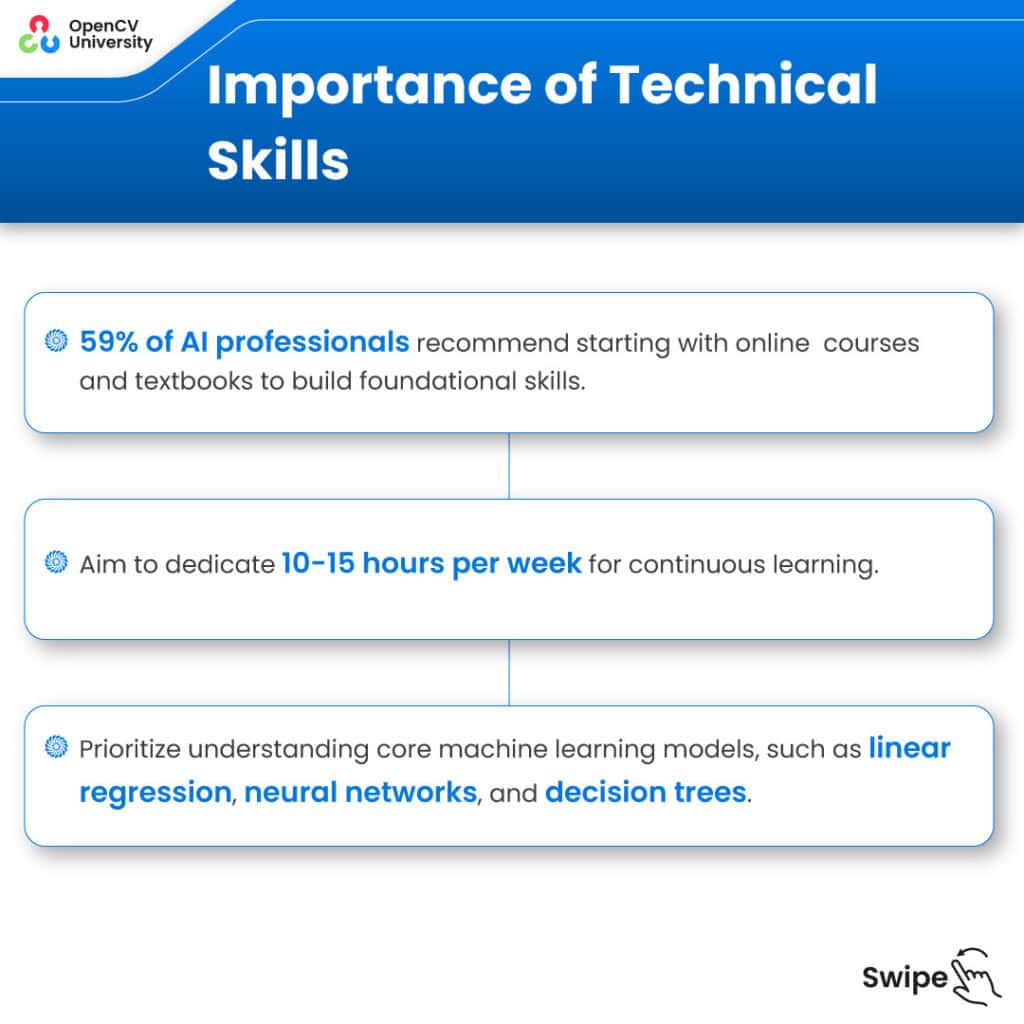


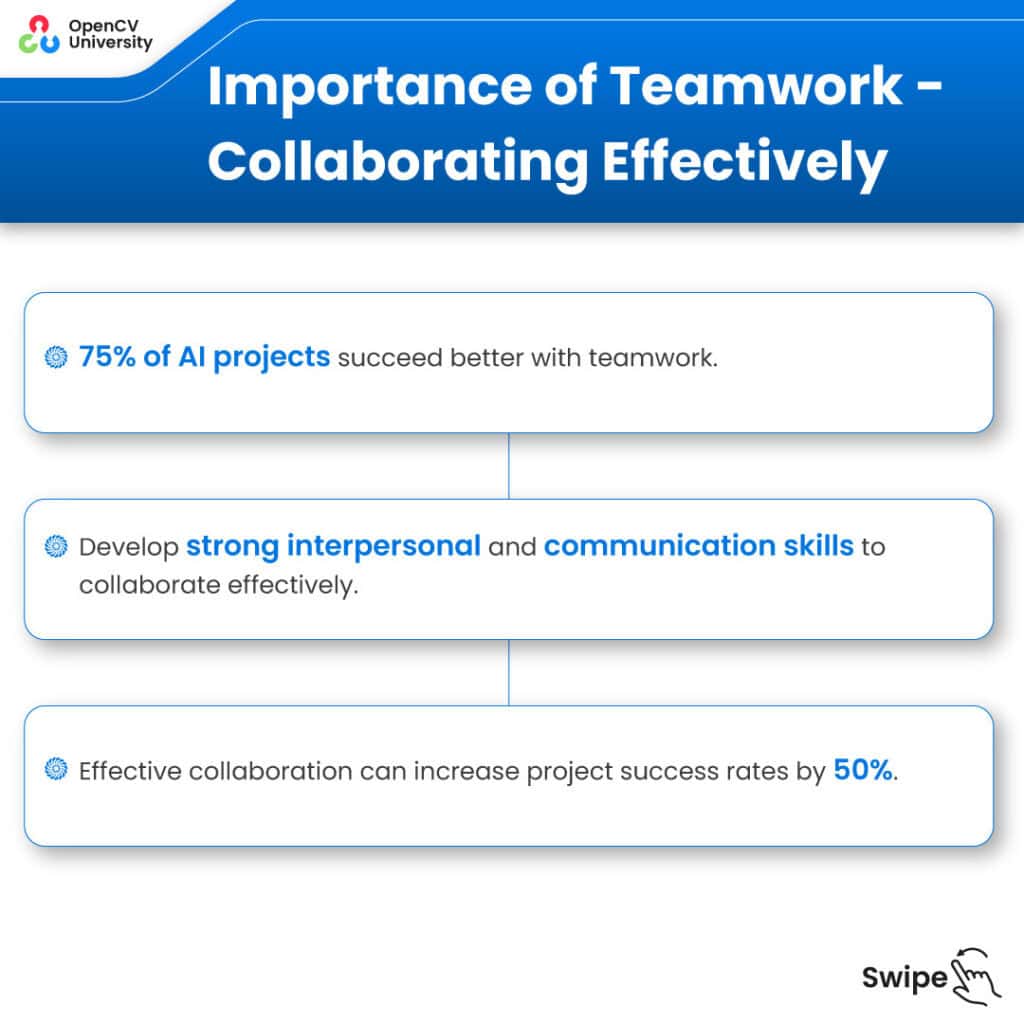



 Programming Skills: If you’re already familiar with languages like Python or C++, you’re on the right track. These languages are widely used in computer vision, particularly Python, due to libraries like OpenCV and TensorFlow. Even a basic understanding of coding can be a great starting point since many tutorials and projects will build on what you already know.
Programming Skills: If you’re already familiar with languages like Python or C++, you’re on the right track. These languages are widely used in computer vision, particularly Python, due to libraries like OpenCV and TensorFlow. Even a basic understanding of coding can be a great starting point since many tutorials and projects will build on what you already know.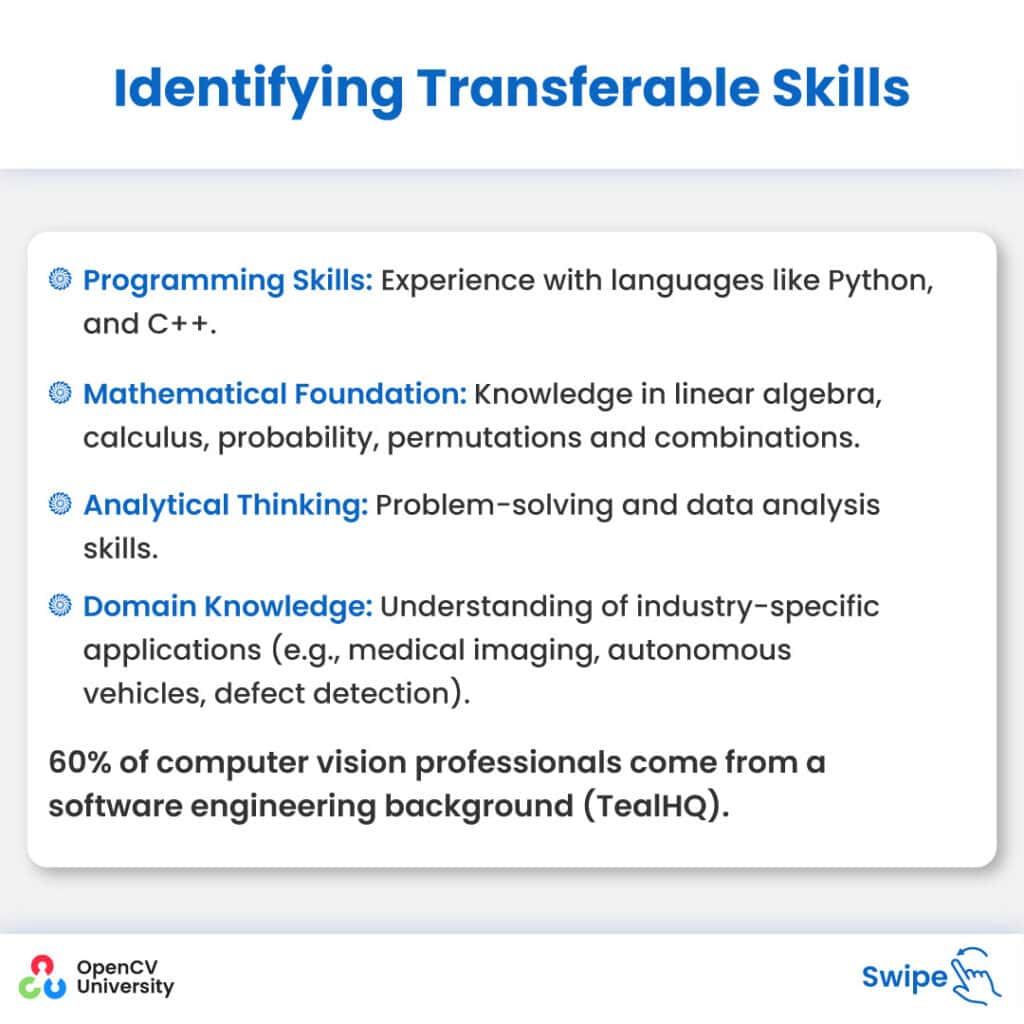
 Online Courses:
Online Courses: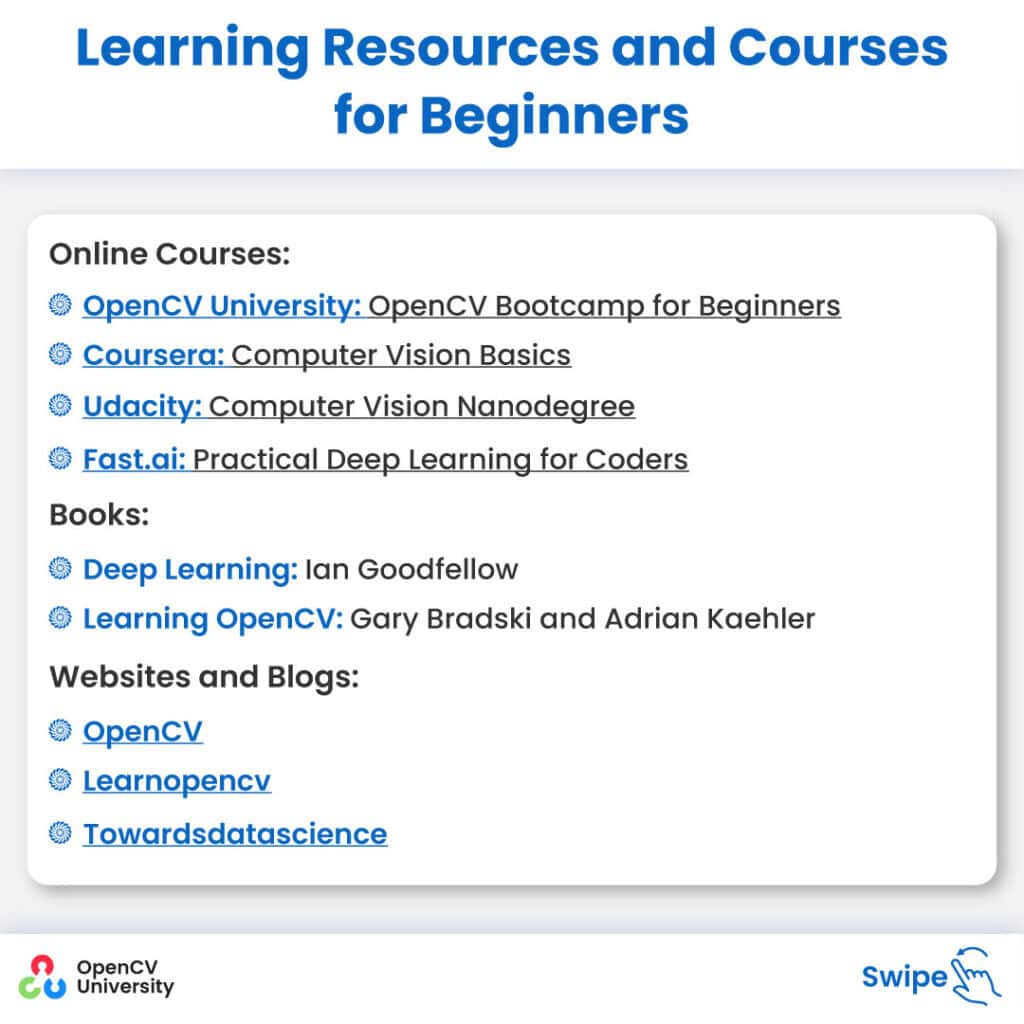
 Start Small: Begin with basic projects, such as image classification or object detection. These foundational tasks are relatively simple but show your ability to work with computer vision tools and datasets. You can find plenty of tutorials and datasets online to guide you through your first projects.
Start Small: Begin with basic projects, such as image classification or object detection. These foundational tasks are relatively simple but show your ability to work with computer vision tools and datasets. You can find plenty of tutorials and datasets online to guide you through your first projects.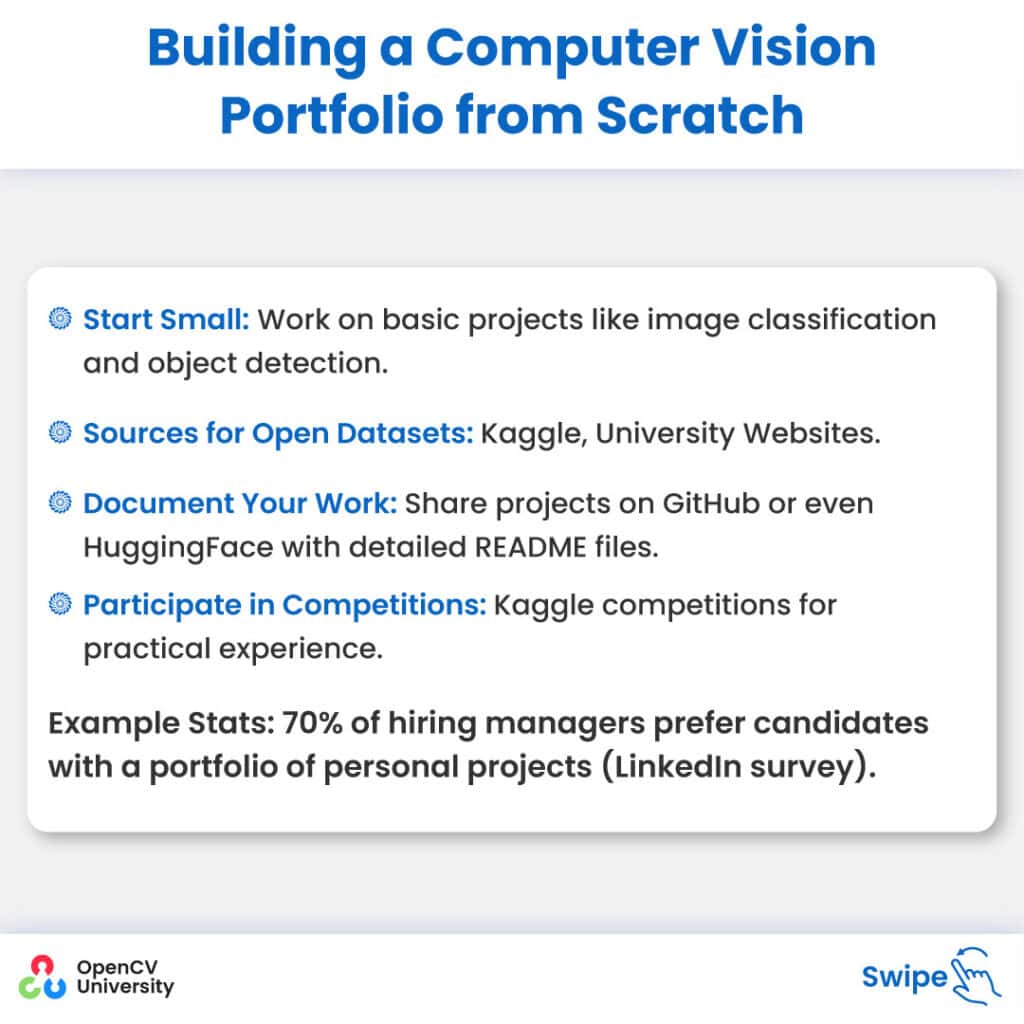
 Join Professional Networks: IEEE, ACM, and local AI meetups.
Join Professional Networks: IEEE, ACM, and local AI meetups.
 Review Your Transferable Skills: Reflect on the programming, analytical, mathematical, and domain-specific knowledge you already possess. These can form a solid foundation as you move into computer vision.
Review Your Transferable Skills: Reflect on the programming, analytical, mathematical, and domain-specific knowledge you already possess. These can form a solid foundation as you move into computer vision.